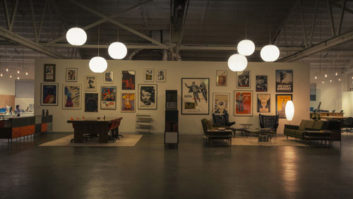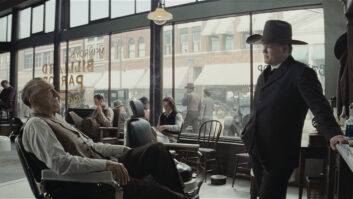In the past couple of years, we’ve gone from surging dotcoms to disappearing dotbombs, and there has never been more uncertainty and confusion about the commercial potential of the Internet. Do banner ads work? What is the true value of a hit on a Website vs. more traditional avenues of marketing and promotion? These questions are being asked in latte-fueled meetings every day, as executives seek the mystical and elusive “bang for the buck” on the Internet. Can we even still believe in the Internet, after it’s given so many of us red ink, pink slips and heartburn?
BMW thinks so. They know that you want a robin’s-egg blue Z-3 to tool around in on weekends, and a steel gray 750iL to shuttle the kids to school. Or maybe I’m just projecting. Anyway, BMW knows that they make cool cars that just about everyone covets, and so they decided on a unique way to market their automobiles, to make them stand out (even more) from the pack. They spent untold millions of dollars to hire five top film directors to make short movies, each involving BMW cars in its story, for the Web (www.bmwfilms.com). The result was some excellent filmmaking and what would have to be deemed a highly successful campaign: Through last summer, the films had drawn more than 3 million viewers — admittedly, not much compared to the audience of a 30-second spot on the Super Bowl, but the hipness quotient of the gesture and the quality of the “commercials” are so high, it’s hard to put a price on this innovative approach to “branding.”
The series, as a whole, is known as “The Hire,” and what each film has in common, aside from gleaming BMWs careening through city streets, purring out on the open road and screeching through claustrophobic parking garages, is actor Clive Owen, who has a certain Bond-ian touch with these fine driving machines. Otherwise, the stories and film styles are quite different: John Frankenheimer (whose Ronin has some of the best chase scenes ever filmed) tells a story about a man who may be smuggling jewels; Crouching Tiger‘s Ang Lee offers a tale involving a young monk; Guy Ritchie (Snatch) provides a hilarious slice of life centered around a bitchy, self-absorbed star, played to perfection by the director’s wife, Madonna; Wong Kar-Wai serves up a dreamy story about romantic distrust; and Alejandro Gonzalez Inarritu spins a story of intrigue involving a photojournalist in a corrupt Latin American country. Each film runs around six to seven minutes, and can be viewed to maximum effect by downloading (free) the BMW Interactive Film Player from the BMW Films Website; it is also available in streaming formats, which give the full audio, but only a distillation of stills from the films. (It’s definitely worth the download time to watch the BMW Player versions.)
The directors and their crews treated each movie like a mini-feature, though, naturally, they had neither the time nor the financial resources to be overly perfectionist. From a sonic perspective, it was challenging work for the sound designers, the production sound crew and the mixers to capture and convey the sounds of the cars (our friendly sponsor) and all the action that each story demanded. For Frankenheimer’s Ambush, for example, the sound design and effects were by one of the best in the business, Ren Klyce (Seven, Fight Club), and it was mixed at a top post house, POP Sound in Los Angeles, by a leading commercial engineer/mixer, Loren Silber. (Additionally, Silber mixed the Wong Kar-Wai and Guy Ritchie films, and supervised the transfer of all five films to DVD last fall.)
Klyce handled his end as he would have a feature, recording the sounds he needed on DAT. “I already had some of what I needed from having worked on a film called The Game, which had a 740 and a 540 BMW,” he says. “But, in general, we spent a lot of time getting the engine sounds from every possible angle. And we’d do dual-miking — one on the engine and one on the exhaust; then we’d filter the two together so you can cut interior or exterior and you wouldn’t lose where you were — you’d still have the thread of the momentum.”
“Ren brought in all his sounds on several DA-88s,” adds Silber, who works in an AMS Neve AudioFile/Logic 2 console environment. “He comped a lot of tracks to reduce the number, and then he brought me the comps [32 tracks’ worth], and we worked from there.”
For the Frankenheimer film, the director wanted “a lot of quick cuts, a lot of action, a lot of screeches and explosions and engines and guns, so the mix challenge was how to hear all the effects through each other,” Silber says. “The way Ren likes to work is, for each little scene there’s something that dominates the scene, and then it usually switches to something else in the next scene. So if it’s a close-up of a gun, that’s going to dominate. If the next shot is a close-up of the wheels, the engine is going to dominate, but you can’t lose the gun, so it’s a tricky balancing act between everything. And to do it all so you can hear it all clearly, and it all sounds powerful and strong, is hard. That’s a very different mix than the Wong Kar-Wai film, which was all music and hardly any dialog. That one, he was in love with the song and it was all about the music.”
Asked about the peculiarities of mixing a film specifically for the Internet, where most people will be hearing it through small speakers, or even in mono, Silber says, “We weren’t sure quite what to do with the Web, because I mix commercials, where you have a legal peak limit. If you’re working on movies, you can go all the way to digital 0 in spots; you can’t do that with a commercial. It’s got to be all compressed. We knew people would be watching on a computer. We also knew they’d probably make a DVD of it. I’m not aware of any peak limits for the Internet. So, basically, we used a wider dynamic range than we would for broadcast, and we made sure it sounded good on a very small speaker. You miss a lot of bass. On stereo speakers, obviously the peaks will be a lot stronger.
“It was Ren’s idea that we should mix it like a film, but do some mastering on it to make sure it sounds okay on a small speaker,” he continues. “So when we mixed it on the big speakers — Genelec 1031s with a subwoofer — we were listening [to it] pretty loud: When a gun went off, you jumped in your chair. But once we got the mix the way we wanted it, we put it on a small speaker and we ended up compressing it a little bit and bringing up some of the lower stuff so you could hear it better. We used the compression on the Logic and we also used some outboard Dominators to get a little more peak limiting. We played with that on and off because the Dominators really clip off the peaks, which is good in some cases, but in the case of gunshots and explosions, it took too much of the edge off.”
For Silber, having to mix with inferior speakers in mind wasn’t too much of a stretch from his work in commercials. As he notes, “At agencies, things sometimes get approved through the oldest ¾-inch machines and the worst TV imaginable,” he laughs. But in this case, Klyce adds, “We mixed to a little 1-inch mono speaker and a 13-inch Sony monitor to make sure we were getting it right for the way many people would be experiencing it. It was tough, especially with the really transient sounds, like gunshots and glass shards, all those things, which have such incredible punch at high volume — you pump them up and they sound great. But here, in the design stage, we had to say, ‘Okay, let’s not get too excited and turn the volume way up because you can fool yourself.’ But working this way makes you focus on the content a little more to get the impact you want, and that’s a good thing.”
What was the nature of the changes that listening on the little speaker demanded? “Usually, dialog had to come up, the effects came down and music was somewhere between,” Silber says. “We didn’t want to change the mix that much, so we ended up usually bringing up the whole dialog track 3 or 6 dB, or something in that range, and we put a compressor over the whole mix sometimes to limit some of the peaks. So you can turn up your computer without distorting your speakers.”
Obviously, the 5.1 mixes for the DVD (which were included free with subscriber copies of Vanity Fair a few months ago) had a different set of sound requirements, and none of the limitations of the Web-friendly mixes. “Of course, you hear more,” Silber says, “but I think the Web version came out well, too. It’s still kind of a new area and people are feeling their way. I think everyone’s sort of waiting for digital TV and what that’s going to do for sound. That will really change everything.”
It remains to be seen whether there will be another round of BMW Films, or if other companies will be inspired by this most creative use of the Internet, but there’s no question that the bar has been raised in terms of audio production for the Web, and that more and more sound designers and engineers will find themselves wondering out loud, “How will this sound in cyberspace?”
Blair Jackson is Mix‘s senior editor.



